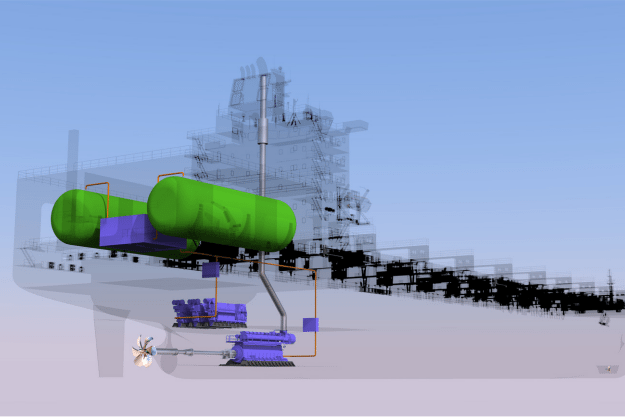Construction is officially underway on the world’s first liquefied natural gas (LNG)-powered containership at the General Dynamics NASSCO shipyard in San Diego, California. The official start of construction kicked off Monday night as the first cut of steel was made for TOTE, Inc.’s new Marlin-class containership during a ceremony at the shipyard. The Marlin class vessels mark a new age in not only American shipbuilding, but in the world as they will be the first newbuild LNG-powered containerships ever constructed. They will also be the largest ships to run on LNG fuel. The 3,100 TEU vessels will come equipped with dual-fuel engines that will operate on either fuel oil or gas derived from LNG, which will significantly decrease emissions while increasing fuel efficiency as compared to conventionally-powered ships. “These ships, will be the most advanced, environmentally progressive vessels of their kind,” state Representative Duncan Hunter (R-CA), Chairman of the House Subcommittee on Coast Guard and Maritime Transportation said, “but they also represent $350 million in U.S. investment, 600 American shipyard jobs, and the bright future of the indispensable domestic maritime industry.” TOTE became the first company in the world to order such ships back in 2012 when it announced that it would be investing in up to five of the new containerships for the Puerto Rico trade. At the same time, TOTE also said it would be converting two of its existing Orca-class Ro/Ro ships to run on LNG. The announcement kicked off what seemed to be flurry LNG-power conversions and newbuilds from U.S. operators like Crowley, Horizon Lines and Matson, who are lured by stricter sulphur emission limits and record U.S. output. “The move to LNG fuel is no less significant than the evolution from sail to steam,” said Mark Tabbutt, Chairman of Saltchuk, TOTE’s parent company, “the Marlins represent the start of a new age in American maritime.” Speakers at Monday night’s event included Representative Duncan Hunter; Acting Maritime Administrator, Chip Jaenichen; Chairman of Saltchuk, TOTE’s parent company, Mark Tabbutt, and Kevin Graney, General Manager of the NASSCO shipyard. “We are excited to begin construction of the lead ship on this historic project,” said Fred Harris, president of General Dynamics NASSCO. “All of the stakeholders on this first-of-a-kind program, including NASSCO, our Korean partners DSEC, TOTE, ABS, and the USCG, are completely focused on its success. We are beginning construction at a level of design, planning and material readiness that is unsurpassed.” The Marlins, which will home port in Jacksonville, Florida, will enter service in late 2015 and early 2016. TOTE recently announced it entered into an agreement with Pivotal LNG and WesPac Midstream to provide LNG to the ships. The new vessels are expected to reduce sulfur dioxide (SOx) emissions by 98 percent, particulate matter (PM) by 99 percent, nitrous oxide (NOx) and carbon dioxide (CO2) by 71 percent over TOTE’s ships currently operating in Puerto Rico.   Marlin-Class Specifications LOA: 764 feet Breadth: 106′ (Panamax) Depth: 60′ Design Draft: 34′ Maine Engine: Dual Fuel Slow Speed Engine Model: MAN8L7OME-C8.2GI Speed: 22 knots Container Size: 40′, 45′ & 53′ |
↧
Steel Cut for World’s First LNG-Powered Containership
↧












